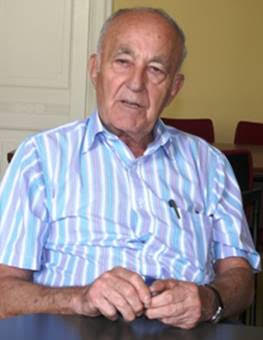
THE VOICE OF INTERNATIONAL LITHUANIA
|
VilNews has its own Google archive! Type a word in the above search box to find any article.
You can also follow us on Facebook. We have two different pages. Click to open and join.
|
Lithuania today
- Posted by - (0) Comment
Vilnius Mayor and
his various roles
We have in recent days had a heated discussion in our VilNews Facebook Forum on whether Vilnius Municipality and the taxpayers should pay for the startup of a new national airline of Lithuania. The debate has subsequently also discussed Mayor Zuokas’ handling of this and other issues, including his dealings with a certain taxi company here in town. Below some of the comments from our VilNews Forum on Facebook:
About the taxpayers

Kostas Cerskus I feel sorry for the tax payers!

Daiva Repeckaite I'm thinking of re-registering in Kaunas to channel my taxes away from Vilnius.
About the planned new airline – AIR LITUANICA

Eythor Edvardsson I think everyone talking here understands the need of good transportation to and from Lithuania. I also believe that airline is a part of a countries identity. People here should not compare to airBaltic who wanted to swallow the world. That is not the case here. Just basic needs as I see it. For lack of flights to and from LT, business suffers but mostly tourism. Lithuania has many great things to offer to the rest of the world, both culture wise as well as business wise.
People forget to calculate why multiple affects great communication brings back to the country as well. I have no fear that this will be going fine.
Why Zokas? This was, if I remember one of his promises before elected, to get things done that the government has been talking about for years with absolutely no success. I have more believe in this in his leadership than in governmental lead. Look forward to see this happen!
Eythor Edvardsson People are coming and going and flight transportation is as necessary as a bridge over a river. You know how much effort I made in this field to see exactly this happen. Who does it is not the case. Just that it is being done.
It is still in my fresh memory when Vilnius was the culture Capital of Europe 2009. What a great opportunity to show the rest of the world the richness in the country’s history and culture. Then, FLYLAL collapsed for all the wrong reasons. And thousands of people who planned to visit the city had no opportunity to do so. All the millions of litas, time and effort of people for years to prepare this cultural year went down the drain. Participation in between 20-30 travel exhibitions around the world were done for nothing. Because? No airline communications. Truly very sad. A great opportunity lost. Driving force in the preparation was the city of Vilnius with Zuokas in the lead. I believe this was hard for him and his people to see and experience. Again, I am happy for LT if this idea gets real wings

Aage Myhre I totally agree with you Eythor Edvardsson. To see a well-founded Lithuanian airline would be nothing but awesome. The question is whether Mayor Zuokas' initiative is a real thing, or if this is just hot air, or maybe something totally different is behind it all?

Sergey Kanovich Every businessman will tell you that the worst business to start is when it is created not out of market needs but out from artificially created interests - someone already mentioned "business" motive - national pride. Which is not a commodity I guess. This market is tough. And all complaining how "bad" is the transport to VNO is not really fair with this statement - you have every major European airline flying in and out. And RyanAir with Wizz Air taking the rest. It is inventing the bicycle. And a nice PR to someone who never had invested a personal penny from his own pocket to all failed projects he had ever initiated before. With what has been published so far this is born to be a failure. I feel really sorry for the taxpayers

Eythor Edvardsson We all know that Zuokas comes with ideas. Some of them materialise, some not. I do hope this one does. Whether there is something ''behind'' this, I cannot see what at this moment. If so, then that will float up one day.

William Adan Pahl A good half the major cities in the USA are in a battle against corruption. Certainly the number is higher worldwide. Las Vegas is a testament to this historically. Before I read up on it will jump on the pro side of this argument in favor of the airline.

Aage Myhre I totally agree with those of you who think that Lithuania should have its own airline, although I personally believe a professional pan-Baltic company, without interference or ownership from the three governments, would be better. Let me give you the example of Norwegian Air Shuttle, which was started by an entrepreneur and a group of investors exactly 10 years ago. Zero governmental participation! Today, this airline is about to become Scandinavia's largest, number 9 in Europe, and in stark contrast to state-owned Scandinavian Airlines having good profits year after year!
See: http://en.wikipedia.org/wiki/Norwegian_Air_Shuttle
![]()
Mayor Zuokas is no Mother Theresa

Sergey Kanovich any "national" mega idea fix is used to drain monies out of the budget (minus 1 billion Lt). That is why I am bit surprised that the driver without a car is paid merely 30,000LT month to make himself busy with trying to prove to 0'Leary that he is completely stupid and is unaware of hidden market possibilities of LT market... The ideas have a price for which he never paid. The price of bad ideas is always higher than the price of good one

Eythor Edvardsson Who the MD is I do not know. But for the right person in this case, 8500 EUR monthly salary would not be a crime.
Sergey Kanovich, when you talk hidden market possibilities, is it something you would like to share with us?

Sergey Kanovich Not a crime??? From a municipal budget with MINUS 1 billion LT that kind of salary is paid to a general without the army? This salary is an overkill in LT by all means. It is immoral to start with. Now, imagine that Reykjavik municipality instead of bringing roads to normal, renovating schools and hospitals etc, etc. having a budget deficit of that scale goes out and tells its citizens - you know what, we will fly you. You will be proud and you will pay for your pride. The rest priorities will wait. I wonder how long Reykjavik's or any other cities mayor would last after such statement. It is a scam. By hidden market possibilities I meant that there are none, because business is driven by market needs. There is no need in this airline. It will not be able to compete. I am sorry, it sounds like a decision to build a copy of Egyptian pyramids which will steal stupid tourist from Egypt.

Daiva Repeckaite A year ago or so, Zuokas promised to pick two homeless men in a shelter and lift them out of poverty. We've never heard of the men again (oops). Otherwise he has a very clear direction - further discriminate and ghettoize the city's poor and create a glossy city for the rich. You might say it is not a crime to prioritize the rich. But public sector redistribution is not necessary for this. The rich can take care of themselves. The purpose of public sector is to have roads, schools and decent living standards available for all.

Eythor Edvardsson Well, we all know Zuokas is no Mother Teresa and never will be.

Daiva Repeckaite Public services are not a charity! It's a government's duty. In 2009, the Conservative-led municipal gov't commissioned a study to find a solution for the Roma housing problem. They considered distributing vans, which would have better sanitary conditions than currently available. After the elections, the Zuokas-led municipal gov't seems to have ditched the study, and Zuokas personally supervised demolitions of the housing that the Roma currently use, in attempts to 'clean' the land before investors are expected to flock there following IKEA's arrival. The airport, btw, is also in the same territory. Not a single public kindergarten was established to meet the ever-growing demand and manage oversubscription. The municipality's lack of interest in urban planning left real estate developers building crammed neighborhoods without schools, parks or even sidewalks (we will see the effect of this in 5-7 years). So, do your basic duties before developing 'ideas'.

Eythor Edvardsson to Daiva Repeckaite: If this ''slice'' is for me, I am not here to stand up for Zuokas in his work. That he can do himself. Again; if for me, you are twisting my words. I come from a country of a strong welfare and I know the meaning if it for a healthy society.
Urban planning and planning in general has always been a mystery to me in Vilnius. It has lead to a chaotic urban areas and I totally agree, will cause problems in future. This city is not growing in a healthy way planning wise.
AIPORT TAXIES

Ulf Hallan Let me add on another perspective. Zuokas has so far started a new taxi company in Vilnius an now wants into the airline competition. What happens to those who actually make their living from this business when they get competition from state or city money? What may we expect next? Vilnius Municipality retail chain? Beauty saloons? Vilnius City Bank?

Daiva Repeckaite Regulations for taxi drivers became much stricter simultaneously. It's true, not all taxi businesses are transparent, but individual drivers barely make a living unless they work a crazy number of hours. When Zuokas taxi was introduced, more meticulous reporting and taxation rules fell on the heads of private businesses. Zuokas may be no Mother Theresa, but he'd better not be Kim Jong-il either.

Eythor Edvardsson No one argues about priorities even though I do want to see a national airline carrier. I will admit that things I am reading here do not look nice at all. This taxi business is at top of my head now because I just arrived back to Vilnius.
I called a taxi from the plane as I was used to do. When the taxi came he drove in circles until he managed to ''steal'' an opportunity for us to jump into the taxi at a dark spot by the airport terminal. So now it is a crime not to take the taxis that are waiting outside the terminal?
- Bookmark :
- Digg
- del.icio.us
- Stumbleupon
- Redit it
- Posted by - (0) Comment
Spring in Vilnius!
It is 8th of March, the International Women’s Day and the beginning of spring in Lithuania. Still snow and ice many places, but the melting process is now obvious. Spring is here!
Photos: Aage Myhre

Two young representatives of the world’s women, in Vokiečių g. in the heart of Vilnius Old Town.

It's starting to turn green on the slopes around Gediminas' Tower.

The danger of avalanches from the old town roofs is now over. Here a rooftop views of
St. Catherine's Church and the Europa Tower on the other side of River Neris.


















- Bookmark :
- Digg
- del.icio.us
- Stumbleupon
- Redit it
- Posted by - (0) Comment
Is Lithuania’s national bird getting lazy?
Many storks no longer
bother flying to Africa
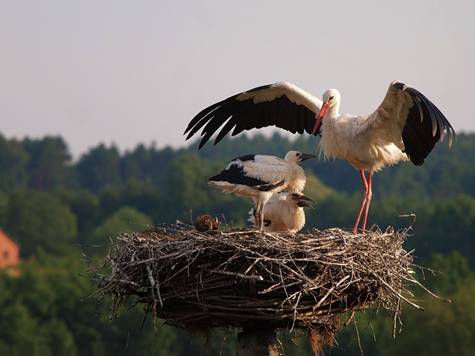
Lithuania has the highest density of white storks in the world,
considered the country’s national bird.
Photo: T. Marčiukaitis www.lietuva.lt
A new project will try to identify why the stork has changed migratory pattern. This writes Science Daily. The investigation has been launched by the University of East Anglia. Since the mid-1980s, a steadily increasing number of storks dropped their annual migration from northern Europe to their winter quarters in Africa.
Instead, both Portugal and Spain are now the final winter destinations for many storks, which feed on large open garbage dumps instead of crossing Sahara as they previously did.
The project will follow 15 adult storks in a year using GPS transmitters. The goal is to examine why they have changed their migratory behavior. GPS transmitters will reveal where storks forage for food and what movements they make between feeding areas.
Before 1995 there were only about 1000 wintering storks in Portugal whereas in 2008 there were over 10,000 wintering storks and the number continues to grow.
It is believed that a combination of climate change and the many open dumps that exist both in Portugal and Spain are among the factors why storks have dropped the long winter trip to Africa.
25 March is Lithuanian Stork Day! See: https://vilnews.com/?p=12622
- Bookmark :
- Digg
- del.icio.us
- Stumbleupon
- Redit it
- Posted by - (0) Comment
KAZIUKO MUGĖ 2013
The wood carver
and the fish woman


Photos: Aage Myhre
I met them at Kaziuko Mugė now this Sunday morning ... The wood carver and the woman who was there to fry fish for the thousands of visitors on the last day of this year's event ... The best outdoor market in the world, and a proud Lithuanian tradition for more than 400 years!
- Bookmark :
- Digg
- del.icio.us
- Stumbleupon
- Redit it
- Posted by - (0) Comment
 By Vin Karnila |
See my slide show: KAZIUKO MUGĖ 2013 from Vilnius, Lithuania CLICK: http://youtu.be/pamXdIGDm2A |
Every year in every town throughout Lithuania, March starts off with the Kaziukas Fair, a ritual that marks the coming of spring, dedicated to St. Casimir, the patron saint of Lithuania. The festival originated in the 17th century, and by the 19th century it had developed into the fair and festival that is now known internationally.
During more ancient times many pilgrims came to Vilnius from various places for the celebration of St. Casimir's Day on the 4th of March which was the day of his passing. After services in the cathedral, the people lingered for a while. And it was this that gave rise to the Kaziukas Fair. Thousands of sellers, buyers and visitors came to these fairs which were held outdoors as they still are today.
I hope you enjoy the slide show of this year’s Kaziuko Mugė I put together for VilNews.com E-Magazine
- Bookmark :
- Digg
- del.icio.us
- Stumbleupon
- Redit it
- Posted by - (2) Comment
It’s again time for
KAZIUKO MUGĖ!
Friday 1 – Sunday 3 March
The world’s best outdoor market
– since the early 1700s!
|
Text and photos: Aage Myhre, Editor-in-Chief It is so genuine that you can hardly believe it without seeing it with your own eyes. Lithuania's Kaziukas Fair (KAZIUKO MUGE) is like an undiscovered, undisrupted island in the huge ocean of 'plastic commercialism' that unfortunately characterizes so much of our today's fairs, markets and festivals. Where else in the world can you find an outdoor market and festival that has been going on continuously through 300 years? What other nowadays' market is a declared plastic-free zone? Where else can you find a single market in which an entire nation's population still participates with enormous enthusiasm? In what other country can one experience what thousands of individuals from the countryside and the cities spend so much of their time through a whole year to produce of genuine artefacts - knitted, crocheted, sewed, carpentry - forged by a people who truly treasure their traditions in handicrafts and folk art? Every single year in every town throughout Lithuania, March starts off with the Kaziukas Fair, a ritual that marks the coming of spring, dedicated to St. Casimir, the patron saint of Lithuania. The festival originated in the 17th century, and by the 19th century it had developed into the fair and festival that is now known internationally. This year's fair takes place Friday 1st – Sunday 3rd of March and will be celebrated throughout the country, as well as in many Lithuanian strongholds around the world, for the complete weekend. But the most genuine ones are of course to find in the very homeland, so please do not wait to check with your travel agent, maybe there still are available tickets! Let’s meet for a mug of local beer and a fresh smoked snack from rural Lithuania!
As for what you can expect to see on the streets of Lithuania's cities this weekend, think first of all of arts and crafts. Craftsmen from all over Lithuania and neighbouring countries flood the streets with their original creations. Here you can buy woodwork, paintings, jewellery, pottery and pretty much everything else you can think of, both in traditional forms and contemporary designs. And what would a Kaziukas Fair be if there was no traditional food to try? Here you can sample a cup of beer or a good old Gira, a plate of porridge, a few pretzels, and if you're lucky you might even get a hold of the traditional potato dumplings, the cepelinai.
In this festival, tradition overpowers the cold and all events will take place outdoors. Before you baulk at the idea of spending time outside in this wintry weather though, consider this: Getting out into the streets in this chilly season, even for a couple of hours, can be a rewarding experience, and with so many nasty cold and flu viruses circulating through the indoor air, it may even be a salvation. And think of all those poor craftsmen, who spend three days from morning till night in the freezing weather, just so you can drop by and be entertained… The Kaziukas Fair is not only a place to sell. It's a place to find new contacts, build relationships with the Vilnius galleries and, of course, to have fun meeting all the craftsmen and exchanging ideas. So take some extra coin, jump into some warm clothes, and off you go to the Kaziukas Fair, be it the one in Vilnius Old Town, or in any other Lithuanian city. During more ancient times many pilgrims came to Vilnius from various Lithuanian places for the celebration of St. Casimir's Day on the 4th of March,. After services in the cathedral, the people lingered for a while. And it was this that gave rise to the Kaziukas Fair. Thousands of sellers, buyers and visitors came to these fairs. They were held outdoors. Another typical Kaziukas Fair product or muginukas, is a heart- shaped honey cookie, decorated with coloured sugar flowers, zigzags, dots and birds. People buy and give them to selected loved ones.
Let me say it again: Check with your travel agent, maybe there still are available airline tickets. We can help you with good hotel deals… |

- Bookmark :
- Digg
- del.icio.us
- Stumbleupon
- Redit it
- Posted by - (1) Comment
SAINT CASIMIR
1458 – 1484
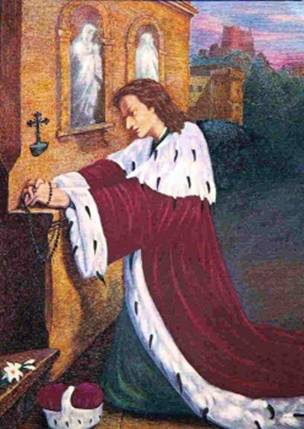
The young prince, Casimir
died at the age of 25 on the 4th of March 1484.
St. Casimir, Lithuania's only Saint, is celebrated on the 4th of March (his death day). This celebration is the origin of the nation's annual Kaziukas Fair.
After his death, St. Casimir was so cherished by Lithuanians that stories of his life and miracles quickly went beyond the church walls and spread through the population and became tales and legends, hence no wonder that he has been so much remembered and celebrated, since the 17th Century primarily through the Kaziukas Fair.
St. Casimir was a true Lithuanian by birth, descending from the famous and respected Gediminaitis clan. The Lithuanian grand dukes Kestutis, Algirdas, Vytautas the Great and others belonged to this family. St. Casimir's father was Kazimieras Jogailaitis who ruled Lithuania (later along with Poland) from 1447.
Kazimieras Jogailaitis married the daughter of Emperor Albrecht II, descended from the Habsburg family. They had six sons and six daughters. Casimir was the second son, born in 1458. He was renowned for a life of great piety, good works and virtue. Upon contracting tuberculosis, he died at the age of 25 on the 4th of March 1484 in the city of Gardinas. He was buried in Vilnius.
Shortly after his death, people started coming in large numbers to visit the holy prince's tomb and pray for intercession with God. His body was associated with numerous miracles and blessings from God. The process to canonize (declare a saint) St. Casimir was begun soon after his death, but for various reasons was delayed until 7 November 1602 when Pope Clement VIII officially proclaimed St. Casimir's feast on the church calendar. It was believed that Casimir had been canonized by Pope Leo X (before 1521) and that Clement VIII merely officially confirmed the fact.
People appealed to their saint at times of various misfortunes. His first miracle is considered to have been his apparition in 1518 at the Dauguva River during the war with Moscow. A large Russian army had assembled and threatened the city of Polotsk. A rather small force of Lithuanians stood to defend the city and fortress. The Lithuanians had to cross the swollen Dauguva River. Unable to find other help, they prayed to the saintly prince to intercede. St. Casimir is said to have appeared to the Lithuanians astride a white horse, wearing a white cloak. He urged the army to fight and rode first into the roaring river. The Lithuanians followed his example, fought fiercely and defeated Moscow's troops. The news of the prince's miraculous apparition and the victory spread throughout the country. The miracle was investigated by bishops of that time and confirmed as authentic. The very fact that St. Casimir came to help in a battle against Lithuania's eternal enemy Moscow elevated him even higher in the eyes of the Lithuanians. The saint became a symbol of the fight against the Russians and Russian Orthodoxy.
Such veneration, so closely linked to anti-Russian feelings, did not go unnoticed by Russia which often occupied Vilnius. Whenever the Russians approached the city, St. Casimir's relics were hidden and taken outside the city; after the danger had passed they were again returned to the church. The Russians made every effort to prevent St. Casimir's veneration; they banned his feast, but were unable to squash the people's enthusiasm. Thousands gathered annually on the 4th of March to pray at the tomb of their beloved saint.
The first church named after St. Casimir was built in Lithuania in the middle or the end of the 16th century near the town Ukmerge. It was built by the Jesuits. At approximately the same time, a church in the saint's honour was built in Vilnius. In Lithuania there are some twelve churches named for St. Casimir.

St. Casimir's Church in the centre of Vilnius is the oldest
Baroque church in Vilnius.
- Bookmark :
- Digg
- del.icio.us
- Stumbleupon
- Redit it
Some pictures from Kaziuko Mugė 2012
- Posted by - (0) Comment
- Bookmark :
- Digg
- del.icio.us
- Stumbleupon
- Redit it
- Posted by - (0) Comment
Lithuanian heating costs reach astronomical heights:
Russian gas up 450%
in just seven years!
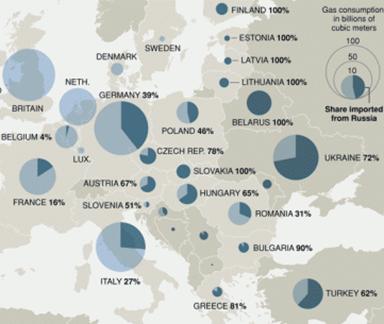
Europe’s dependence on Russian gas.
Lithuania pays 15% more than Latvia and Estonia,
25% more than Germany for the same Russian gas.
While gas prices have tended to fall globally in recent years thanks to deposits of shale gas in places like the U.S., Lithuanian households have looked on in horror in the past seven years as the retail cost of natural gas pumped from Siberia spiked 450 percent — or from $169 to $769 per 1,000 cubic meters.
This writes the Associated Press in an article this week, where they more than suggest that Russia uses its natural gas as a pressure point against Lithuania.
Lithuanians have seen prices soar over the past several years, especially since the shuttering of its only nuclear power plant in 2009, forcing the country to import more Russian gas to keep warm. Lithuania's decision to scrap atomic power over safety concerns has put it under a new kind of threat: intimidation from Russia, which critics say shows no hesitation to use its energy dominance to bully former vassal states.
Lithuania currently pays Russia a wholesale price of about $540 per 1,000 cubic meters of natural gas piped from Siberia, roughly 15 percent more than Baltic neighbors Latvia and Estonia and 25 percent more than Germany, writes Associated Press.
- Bookmark :
- Digg
- del.icio.us
- Stumbleupon
- Redit it
- Posted by - (0) Comment
Paul Krugman, New York Times:
Is there any country where austerity policies have been a success?
In an opinion article in New York Times this week, Mr. Krugman writes:
Today I’d like to talk about the frantic effort to find some example, somewhere, of austerity policies that succeeded. For the advocates of fiscal austerity — the austerians — made promises as well as threats: austerity, they claimed, would both avert crisis and lead to prosperity.
For the advocates of fiscal austerity — the austerians — made promises as well as threats: austerity, they claimed, would both avert crisis and lead to prosperity.
And let nobody accuse the austerians of lacking a sense of romance; in fact, they’ve spent years looking for Mr. Goodpain.
- Bookmark :
- Digg
- del.icio.us
- Stumbleupon
- Redit it
- Posted by - (0) Comment
Has the spirit of
January 1991 returned?

Is there a new Lithuanian awakening in the making?
What do you, dear reader, think?
By Aage Myhre, editor-in-chief
aage.myhre@VilNews.com
The 22 years that have passed since January 1991, when the Lithuanian people in an exemplary, peaceful manner stood up against the violent Soviet re-occupation, have only rarely lived up to the expectations I and many with me had by then.
Neither Landsbergis, Brazauskas, nor later leaders delivered when the new statehood was to be developed during the 1990s.
The country's newfound freedom did not lead to the type of growth and better living conditions for the broad masses, that had been expected. Also, the warmer, friendlier and more human society we all waited for never occurred. When the people who had shown their support for the new won independence from the Soviet Union returned to their towns and villages in the spring of 1991, much of the community spirit was gone and did not appear since.
Different leaders have since those days made some half-hearted attempts to regain team feeling, cooperation and community spirit within groups of the Lithuanian people. These attempts have largely been met with shrug and distrust, and few politicians have gained genuine respect of their own people.
The EU membership in 2004 did not become the boost that had been expected. Certainly, the economy enjoyed a positive step forward, but not much positive happened for the broad masses of the people.
Therefore, the most striking result of the membership and the open borders to the West, was a mass exodus unparalleled in and for any other country of today.
The enormous crisis that began in 2008 made the situation even worse, almost unbearable for many, and one felt that it was only a matter of time before the country would collapse, emptied of inhabitants.
Then, a year or two ago, I felt that something was happening down in the grassroots of business people and others. I discovered more and more young professionals who began to define their own paths, no longer waiting for the older generations of leaders to show the way.
When I this year marked 13 January in the Lithuanian Parliament Building, 22 years after I in 1991 stood there with Professor Landsbergis looking out the window at the bonfires, barricades and the huge crowd of unarmed people who had gathered to protect their president and the country's future as a free nation, I saw something completely new to me.
I was, now in 2013, there with a group of young Lithuanians, most of them so young that they do not have their own memories of what happened there 22 years ago. Yet the memories of the sad events in January 1991 were obviously alive and present for them. They wanted to underline that freedom and independence is not something one can take for granted. I was there with some of Lithuania's future politicians – young, well-educated, smart leaders that this country a few years ago could only dream about.
I walked around with them in the Parliament this 13th January. I saw their interests, and their pride in belonging to a great nation like this.
I also saw large photographs on the walls, with Lithuania's parliamentary history of the interwar time and from the years after the Declaration of Independence 11 March 1990. The sadness I felt when I walked around in these corridors 22 years was gone, now I felt only joy, and optimism regarding the country's future and its political leaders for the years to soon come.
I had, before this visit, seen young Lithuanian business people in full swing building up more professional structures and attitudes. That I now saw the same happen among young politicians was very gratifying.
Both of these groups feel to some extent that our brand new government is a step backwards, back to the "nomenclature times", but their young, Western-type way of thinking is certainly very encouraging and I think we are facing a crossroads which bodes well for Lithuania!
It is precisely such attitudes I now see more and more of among young Lithuanians. And this time, it appears that they are ready to take matters into their own hands, no longer waiting for the older politicians and leaders to show the way. It almost feels as if the spirit of January 1991 is back, now in a structured, pragmatic and professional manner.
What do you, dear reader, think? Is there a new awakening in the making? Has the spirit of 1991 returned?
- Bookmark :
- Digg
- del.icio.us
- Stumbleupon
- Redit it
- Posted by - (1) Comment
The 2012 Parliament

| Political groups | Social Democratic (38) |
The Seimas of the Lithuanian Republic (Lithuanian: Lietuvos Respublikos Seimas), or simply the Seimas is the unicameral Lithuanian parliament. It has 141 members that are elected for a four-year term. About half of the members of this legislative body are elected in individual constituencies (71), and the other half (70) are elected by nationwide vote according to proportional representation. A party must receive at least 5%, and a multi-party union at least 7%, of the national vote to be represented in the Seimas.
Latest election
| Party | Proportional | Constituency | Total | +/– | ||
| Votes | % | Seats | ||||
| 251,610 | 18.37 | 15 | 23 | 38 |
| |
| 206,590 | 15.08 | 13 | 20 | 33 |
| |
| 271,520 | 19.82 | 17 | 12 | 29 |
| |
| 100,120 | 7.31 | 6 | 5 | 11 |
| |
| 117,476 | 8.57 | 7 | 3 | 10 |
| |
| 79,840 | 5.83 | 5 | 3 | 8 |
| |
| 109,448 | 7.99 | 7 | – | 7 | New | |
| 53,141 | 3.88 | – | 1 | 1 |
| |
| 28,263 | 2.06 | – | – | – |
| |
| 24,129 | 1.76 | – | – | – | New | |
| 16,515 | 1.21 | – | – | – |
| |
| 16,494 | 1.20 | – | – | – | New | |
| For Lithuania in Lithuania | 12,854 | 0.94 | – | – | – | New |
| 8,632 | 0.63 | – | – | – |
| |
| Democratic Labour and Unity Party | 4,383 | 0.32 | – | – | – | New |
| Emigrants Party | 4,015 | 0.29 | – | – | – | New |
| Republican Party | 3,661 | 0.27 | – | – | – | New |
| Lithuanian People's Party | 3,399 | 0.25 | – | – | – | New |
| Independents | – | – | – | 3 | 3 |
|
| Invalid/blank votes | 57,924 | – | – | – | – | – |
| Total | 1,370,014 | 100 | 70 | 70 (1 to go) | 140 | – |
| Registered voters/turnout | 2,588,418 | 52.93 | – | – | – | – |
| Source: VRK | ||||||
- Bookmark :
- Digg
- del.icio.us
- Stumbleupon
- Redit it
- Posted by - (0) Comment
CELEBRATING WINTER SOLSTICE

By Waverly Fitzgerald
The Winter Solstice is unique among days of the year — the time of the longest night and the shortest day. The dark triumphs but only briefly. For the Solstice is also a turning point. From now on (until the Summer Solstice, at any rate), the nights grow shorter and the days grow longer, the dark wanes and the Sun waxes in power. From the dark womb of the night, the light is born.
Many of the customs associated with the Winter Solstice (and therefore with other midwinter festivals such as St Lucy’s Day, Saturnalia, Hanukkah, New Years and Twelfth Night) derive from stories of a mighty battle between the dark and the light, which is won, naturally, by the light. Other traditions record this as the time a savior (the Sun-Child) is born to a virgin mother.
The Battle Between Old and New, Dark and Light
The Romans celebrated from December 17th to December 24th with a festival called Saturnalia, during which all work was put aside in favor of feasting and gambling. The social order was reversed, with masters waiting on their slaves. The Saturnalia is named after Saturn, who is often depicted with a sickle like the figures of Death or Old Father Time. Astrologically speaking, Saturn is saturnine: gloomy, old, dutiful and heavy. He was the god who ate his own children rather than let them surpass him. For new life to flourish, for the sun to rise again, it is necessary to vanquish this gloomy old fellow. Therefore, the feasting and merriment of the midwinter season are religiously mandated in order to combat the forces of gloom.
The day following the Saturnalia, was the Juvenalia, according to Z Budapest in The Grandmother of Time, a holiday in honor of children who were entertained, feasted and given good luck talismans. This makes sense. After vanquishing the Old King, it’s time to celebrate the new in the form of children, the New Year's Baby, the Son of Man. Naturally this is the time of the year at which the birth of Christ is celebrated, since he is also the New King, the Light of the World who brings light.
The Birth of the Sun
Christ’s birthday was not celebrated on December 25th until the 4th century. Before then, December 25th was best known as the birthday of the Persian hero and sun-god, Mithra. The myth tells that he sprang up full-grown from a rock, armed with a knife and carrying a torch. Shepherds watched his miraculous appearance and hurried to greet him with the first fruits of their flocks and their harvests. The cult of Mithra spread all over the Roman empire. In 274 AD, the Roman emperor Valerian declared December 25th the Birthday of Sol Invictus, the Unconquerable Sun.
Christ was also not the first miraculous child born to a virgin mother. As Marina Warner points out, “the virgin birth of heroes and sages was a widespread formula in the Hellenistic world: Pythagorus, Plato, Alexander were all believed to be born of woman by the power of a holy spirit.”
The union of a virgin and a supernatural force, like the couplings between Zeus and various nymphs, was shorthand indicating the presence of a miraculous child, a child with the powers of both worlds. Dionysus is such a child, born of a union between Zeus and Semele.
Parke in Festivals of the Athenians describes a women-only midwinter festival, the Lenaia, which honored Dionysos. On this night, Greek women “held their ecstatic dances in winter — fully clothed in Greek dress, with castanets or the thyrsus, dancing together with no male companions, human or satyr.” Graves calls it the Lenaea, the Festival of Wild Women (a nice companion for the Festival of Merry Women on Dec 14). He says a bull, representing Dionysus, was cut into nine pieces, with one piece being burned and the rest consumed raw by the worshippers. Dionysus was born in winter, crowned with serpents, became a lion in the spring and was sacrificed as a bull (stag or goat) in the summer because these were calendar emblems of the old tripartite year. Marija Gimbutas in Goddesses and Gods of Old Europe calls Dionysus a Year God. Mithra was also associated with the bull (his initates were baptized with the blood of a sacrificed bull) and shown with the emblems of the zodiac surrounding him, suggesting that he is also a Year God.
The Lenaia occurred on the twelfth day of the Greek lunar month, Gamelion, which falls in early winter. The twelfth day of a lunar month (which begins with the new moon) always falls on a full moon night. If we move this lunar festival to the solar calendar and count from the winter solstice, the festival would occur on January 5th or 6th.
Until the fourth century, Christ’s birthday was celebrated on January 6th, on the same date when the Virgin Kore gave birth to the year god celebrated in Alexandria with a festival called the Koreion. St. Epiphanius complains about the hideous mockery of this rite but it preceded the story of Christ’s birth. In the original ritual, the image of the goddess, decorated with gold stars, was carried seven times around her temple as the priests cried, “The Virgin has brought forth the new Aeon!”
Although Aeon, or Eon, is now defined as “an indefinitely long period of time; an age, eternity,” its Indo-European root aiw conveyed “vital force, life, long life, eternity,” and the Greek form Aion meant specifically “vital force.” [Farias]
This description recalls the Egyptian ceremony re-enacting the birth of Horus, the sun-god to Isis. All lights in the city were doused while Isis circled the sarcophagus seven times, then brought forth Horus who was called “the Light of the World.” Statues of Isis holding the newly born sun god on her lap, presenting him to the world, are similar to pose to later statues representing Mary and Jesus.

Festival of Lights
The return of the light is the most prominent feature of most midwinter festivals. In Sweden on St. Lucy’s Day, young girls don white dresses and a wreath of candles and awaken their families with cakes and song. Hanukkah, the Festival of Lights, is celebrated by lighting candles over a span of eight days. The Christian custom of the Advent wreath, with its four candles, one lit each of the Sundays before Christmas, is another way of re-kindling the light.
The Christmas candle, a large candle of red or some other bright color decorated with holly or other evergreens, was at one time a popular custom throughout Great Britain, Ireland and Scandinavia. One person, usually the eldest or the head of the household, is designated as the lightbringer. She lights the candle for the first time on Christmas Eve before the festive supper and during each of the remaining evenings of the Twelve Days of Christmas. To extinguish the candle, she snuffs it with tongs rather than blowing it out, since that would blow the luck away. The candle sheds a blessing on the household and so is protected from accidental quenching. It seems likely that the candle also represented the coming year, just as the weather of each of the twelve days of Christmas foretell the weather of the corresponding month. It had protective or fertilizing powers and was kept as a charm. In Denmark, during a lightning storm, the remnant would be brought out and lit to protect the household.
Similar customs once surrounded the Yule log. The Yule log must never be bought but should be received as a gift, found or taken from you own property. Often the log to be burned at midwinter was chosen early in the year and set aside.
Tradition varies about the type of wood to be used. Oak logs were popular in the north of England, birch in Scotland and ash in Cornwall and Devon. Ash is the only wood that burns freely when green and the world-tree, Yggdrasil, in the Nordic tradition was an ash-tree. It is important that the Yule log be the biggest and greenest log available since the Christmas festivities will last only as long as the Yule log burns.
In some parts of the Scottish highlands, the head of the household finds a withered stump and carves it into the likeness of an old woman, the Cailleach Nollaich or Christmas Old Wife, a sinister being representing the evils of winter and death. She's the goddess of winter, the hag of night, the old one who brings death. Burning her drives away the winter and protects the occupants of the household from death.
The Yule log is first brought into the house with great ceremony on Christmas Eve (or the eve of solstice, if one prefers). Usually it is decorated with holly and ivy and other evergreens of the season. Some people prefer to use the Yule log as a decoration and place candles on it instead, thus transforming it into a candleabra like the menorah or the kinara. It is lit with a piece of last year's log as described in Herrick’s poem, “Hesperides:”
Come bring with a noise
My merry, merry boys
The Christmas log to the firing
With the last year's brand.
Light the new block,
And for good success in his spending
On your psalteries play:
That sweet luck may
Come while the log is a-teendling.
In Italy, the Yule log is called the Ceppo. Boccaccio in the fourteenth century described a Florentine family gathering about the hearth and pouring a libation of wine upon the glowing wood, then sharing the remaining wine, thus linking the Yule log with the custom of wassailing, pouring out libations to the trees in the orchard.
The Yule log is left to burn all night, and, if possible, through the next twelve without going out, although it may be extinguished with water. The ashes are kept for good luck. They have magical properties and can be scattered in the field to fertilize the soil or sprinkled around the house for protection.
The Solstice Evergreen
Another ancient midwinter custom is decorating with greens. The Romans decorated with rosemary, bay, laurel, holly, ivy and mistletoe. The holly and ivy were both important midwinter plants in Great Britain and Ireland, as seen in the mysterious medieval carol which mentions the rivalry between them. Matthews in The Winter Solstice provides the lyrics of a 15th century carol which refers to an ancient battle between the two, with the Ivy representing the cold gloominess of winter and the Holly King, the jolly spirit of the season.
The Christmas tree is of more recent origin. In her book, The Solstice Evergreen, Sheryl Ann Karas says that the earliest record of an evergreen being decorated comes from Riga in Latvia in 1519, when a group of local merchants carried an evergreen bedecked with flowers to the marketplace, where they danced around it and then burned it. Another possible source is the custom in 15th and 16th century Germany of hanging apples on a fir tree as a prop for the miracle play performed on Christmas eve depicting Adam and Eve being driven out of Paradise (see Dec 24).
Celebrating Yule
You should enjoy yourself as much as possible on the Winter Solstice because this will bring back light (and lightness) into the world. Different traditions mention feasting, gambling, playing pranks, giving gifts, visiting, drinking, dressing up, fornicating, putting on plays and staying up all night. During the dark of winter, invoke all the forces of pleasure and love which make life worth living.
Decorating for this festival is easy since you can use all your Christmas decorations. Evergreens and wreaths represent rebirth and the circle of life. Fill your home with candles and Christmas lights. Place them on mirrors, hang up lots of sparkly ornaments and prisms and tinsel so you can create as much light as possible.

Sitting in the Dark
Earlier traditions focused on the battle between the dark and the light, but we know both are valuable. Honor the dark before calling in the light. This is the season when animals hibernate and nature sleeps and we can turn inward too. Perhaps some of the depression people feel during the holidays comes from not providing a space for feeling the sadness associated with this season. Set aside time (hard to do amidst the frenzy of the holidays) for sitting in the dark and quiet. I like to spend the entire day of the Winter Solstice in silence and reflection.
This is a natural time for letting go and saying farewell. Release your resentments and regrets into the darkness, knowing they will be transformed. Write about them in your journal or write them on slips of paper which you can burn in your Yule fire. Use your holiday cards to make amends to people you've hurt or neglected.
Welcoming the Light
When you light your candles and your fire, do so with the intention of bringing light into the world. What are the ways in which you can help make the world lighter? How do you bring light into the lives of those around you? Make a conscious effort to increase the amount of light you create. Nancy Brady Cunningham describes a simple yet elegant Winter Solstice ritual in Feeding the Spirit which is appropriate for a large group or a couple, for children and adults, and for people of all religious persuasions. It goes something like this:
Decorate a room with winter greenery. Place a large bowl of water and a candle in the center of the room. Have some gold glitter and scented oil nearby. Give each of the participants a candle (with some kind of holder if you’re worried about drips). Everyone sits in a circle with a lit candle in front of them and talks about their losses, putting out their candle when they're done speaking. When all are done, the central candle is extinguished and everyone sits in the darkness reflecting on what they have lost. After a long silence, the leader relights the central candle which represents the sun and sprinkles the gold glitter on the water. Everyone lights their candles from the central candle and places them by the water so they can watch the glitter sparkling there. This is a good time to sing a sun song, like “Here Comes the Sun,” or “You Are My Sunshine.” Pass around a glass of wine or juice and toast the sun. The sun-child is the child of promise. Everyone can talk about a promise they see in the future. The leader puts the scented oil in the water and anoints each person with sunshine by dipping her hand into the sparkling, scented water and sprinkling it over each person’s hair.
I do a similar ritual at my Winter Solstice party. When the guests arrive the house is bright with Christmas lights and candles, but at some point during the evening I turn off the lights and blow out the candles and ask the guests to spend a few moments in the darkness and silence reflecting on these qualities of the winter. Then I tell the story of St Lucy and play the traditional Lucy song. As the song is playing, from out of the darkness, faint at first and growing stronger, comes the wavering light of a candle, carried by St Lucy (a role which is coveted by the younger members of the party). She is dressed in white with a crown of candles on her head and her face as she advances through the darkness, ever so intent on the candle she carries before her, is radiant. There is usually a gasp from the assembled guests, so numinous is this figure. St Lucy lights the central candle in the Advent wreath, then I invite the guests to bring their own candles to the flame to light them and make a wish for the New Year. St Lucy disappears into the darkness to reappear again as Shaw or Leah or Amy, and the house is soon full of lights and noise as we talk and listen to carols and feast on the thirteen kinds of Christmas cookies I prepare for this occasion.

- Bookmark :
- Digg
- del.icio.us
- Stumbleupon
- Redit it
- Posted by - (0) Comment
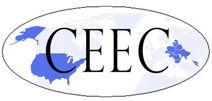
Eastern Europe's
watchdog in the U.S.
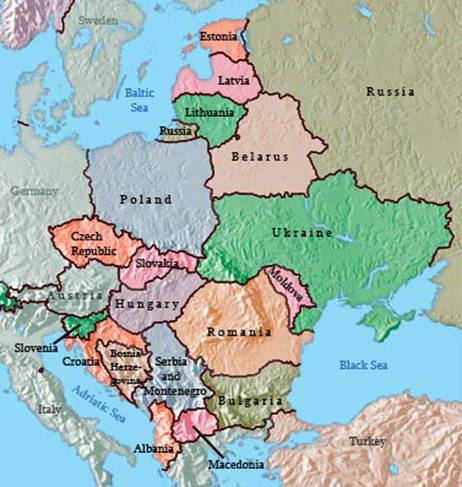
A constantly relevant focus of CEEC is Russia's increased use of "soft power" against
Lithuania and the other 17 countries that constitute Central and Eastern Europe.
Member of our VilNews Honorary Council and regular contributor as a columnist, Dr. Stan Backaitis, is also a member of the Central and East European Coalition (CEEC), Eastern Europe's watchdog in the United States. A constantly relevant focus of this organization is Russia's increased use of "soft power" against Lithuania and the other 17 countries that constitute CEE. Dr. Backaitis today has made us aware of a new U.S. law in the country's relations with Russia. The new law grants Russia and Moldova permanent normal trade relations, but it is coupled with the Sergei Magnitsky Rule of Law Accountability Act, which honors a dead Russian. The law blacklists Russians connected to the death of Magnitsky in police custody and to other gross human rights violations, prohibiting entrance to the United States and use of its banking system.
The Central and East European Coalition (CEEC) was established in 1994 and is comprised of 18 national membership organizations that represent more than 22 million Americans who trace their heritage to the countries of Central and Eastern Europe (CEE). CEEC represents Americans of Armenian, Belarusan, Bulgarian, Czech, Estonian, Georgian, Hungarian, Latvian, Lithuanian, Polish, Romanian, Slovak, and Ukrainian descent.
The CEEC has been regularly consulted by U.S. authorities over the years on a variety of issues, such as NATO enlargement, U.S. assistance to Central and Eastern Europe, Bosnia, Kosovo, the Comprehensive Nuclear Test Ban Treaty, missile defense, and other key issues of national concern. Our member organizations regularly meet individually and as a Coalition, with high-level officials at the White House, State Department, and members of Congress.
The latest, growing tense situation between Russia and its neighbors has caused increased alarm for CEEC as Moscow’s increasingly belligerent rhetoric, internal violations of human rights, economic coercion, and increasing use of soft power to further its aims, have gone largely unheeded in American foreign policy.
CEEC has the latest years also focused much on energy issues, that have emerged as one of Europe’s most serious long-term security challenges, with the Kremlin using its energy resources for political and economic pressure in the CEE region.
- Bookmark :
- Digg
- del.icio.us
- Stumbleupon
- Redit it
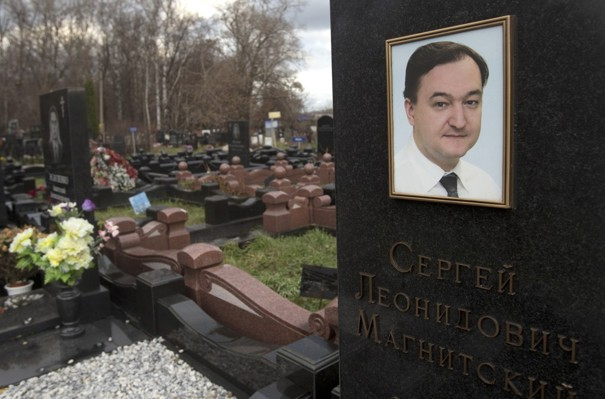
A tombstone on the grave of lawyer Sergei Magnitsky, who died in jail, at a cemetery in Moscow. A new law blacklists Russians connected to the death of Magnitsky in police custody.
The Washington Post
MOSCOW — The U.S. Senate on Thursday repealed a trade sanction imposed 38 years ago to force the Soviet Union to allow Jews and other religious minorities to emigrate, replacing it with a modern-day punishment for human rights abuse that has enraged Russian officials.
The old law, one of the last vestiges of the Cold War, was called the Jackson-Vanik Amendment, named after a U.S. senator and a representative. The new law, passed 92 to 4, grants Russia and Moldova permanent normal trade relations, but it is coupled with the Sergei Magnitsky Rule of Law Accountability Act, which honors a dead Russian. The law blacklists Russians connected to the death of Magnitsky in police custody and to other gross human rights violations, prohibiting entrance to the United States and use of its banking system. office in 2000, Vladimir Putin has expanded the powers of Russia's presidency, consolidating authority in the Kremlin and weakening other democratic institutions.
“Today, we close a chapter in U.S. history,” Sen. Benjamin L. Cardin (D-Md.), one of the prime movers of the Magnitsky bill, said during the debate on Jackson-Vanik. “It served its purpose. Today, we open a new chapter in U.S. leadership for human rights.”
How the United States can best promote democracy and human rights in Russia — and elsewhere — became a matter of agonizing and often bitter debate as pressure grew to repeal Jackson-Vanik. Not only was it widely considered a relic with the dissolution of the Soviet Union in 1991 and freedom to emigrate from Russia, but, under the regulations of the World Trade Organization, which Russia joined this year, it also penalized American exporters.
The House approved the measure last month. President Obama said he looked forward to signing the law because of the WTO benefits for American workers, although originally the administration had argued that the Magnitsky bill was unnecessary because the president could — and would — create the desired blacklist by executive order.
“My administration will continue to work with Congress and our partners to support those seeking a free and democratic future for Russia and promote the rule of law and respect for human rights around the world,” Obama said in a statement.
“We need the Magnitsky act to fill the gaps in President Obama’s policy,” said Sen. Orrin G. Hatch (R-Utah), criticizing Obama for what he called unseemly efforts to avoid offending Russian President Vladimir Putin.
Russia, as expected, was infuriated. Speaking in Brussels on Thursday, Moscow’s special representative on human rights and democracy predicted a tough response, Interfax reported.
“We regard it as unjust and unfounded,” Konstantin Dolgov said. “This is an attempt to interfere in our internal affairs.”
Sen. Jon Kyl (R-Ariz) said the bill should have applied to all countries. The House, however, had already passed the Russia-centric bill, and the Senate decided to go along.
Sen. Jeanne Shaheen (D-N.H.) said, though, that the United States intends to pay attention to human rights everywhere.
“We will stand up for those who dare to speak out against corruption,” she said. “This bill is for all the Magnitskys around the world.”
Cardin, chairman of the U.S. Helsinki Commission, has been pushing for a Magnitsky law since 2010, when most of his colleagues stumbled over pronouncing the Russian name. Debating the bill Wednesday, senator after senator recounted Magnitsky’s life story, his name rolling familiarly off their tongues.
Magnitsky was working for an American law firm in Moscow, advising Hermitage Capital on tax issues, when he discovered a $230 million tax fraud being carried out by Russian police and tax officials using documents stolen from the investment company, run by the American-born William F. Browder.
When Magnitsky accused officials, they arrested him. Magnitsky died in pretrial custody in November 2009 after nearly a year in jail. Despite evidence that he had been beaten and tortured, no one has been punished, and Magnitsky is being prosecuted posthumously.
Browder first testified to the Helsinki Commission about Magnitsky’s imprisonment several months before the Russian’s death. On Thursday, he said he hoped the Senate action would encourage passage of a similar law in Canada and Europe.
Sen. John McCain (R-Ariz.) said the United States had a moral obligation to speak out for Magnitsky, as well as others who are still alive and languishing unjustly in Russian prisons.
“I continue to worry about them,” McCain said, “and I pray for them.”
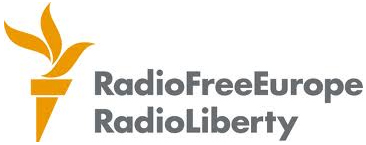
U.S. LIFTS RUSSIA, MOLDOVA TRADE BARRIERS;
PASSES MAGNITSKY SANCTIONS
Richard Solash
December 6, 2012
WASHINGTON -- The U.S. Senate has voted to permanently lift Cold War-era barriers to trade with Russia, a move long sought by Moscow that could increase commerce between the countries by billions of dollars.
In the same vote on December 6, senators also backed sanctions against Russian officials implicated in the death of anti corruption lawyer Sergei Magnitsky and in other perceived gross rights violations in Russia.
Moscow has railed against that move, which has overshadowed the trade benefits to come.
The Senate's 92-4 vote follows the passing of the bill in the U.S. House of Representatives in November. In a statement, U.S. President Barack Obama said "I look forward to receiving and signing this legislation."
When he does, Moscow will be exempted from the 1974 Jackson-Vanik Amendment, which imposed trade restrictions on the Soviet Union for its policy of limiting Jewish emigration. The restrictions have been waived for nearly two decades but remained on the books as a symbol of U.S. objections to Russia's human rights record.
Citing the weak U.S. economy, the White House had pushed Congress to lift the restrictions and grant Permanent Normal Trade Relations (PNTR) status to Russia, the world's seventh-largest economy.
The move allows the United States to take full advantage of Moscow’s August entry into the World Trade Organization, which has already benefited China and Europe.
Over White House objections, lawmakers from both parties said they would only agree to lift the restrictions if the Sergei Magnitsky Rule of Law Accountability Act were passed concurrently.
The legislation requires Obama to deny visas to, and freeze the U.S.-based assets of Russian officials whom the United States has implicated in Magnitsky’s prosecution and death, as well as officials implicated in other gross violations in Russia who have acted with impunity.
In determining who will be sanctioned, the president is expected to work from a list of more than 60 Russian officials compiled by lawmakers who introduced the legislation.
Obama can decide to keep the identities of some of the sanctioned officials classified for national security reasons.
'A New Chapter On Human Rights'
Senator Benjamin Cardin (Democrat-Maryland), the earliest and most passionate advocate of sanctions in Congress, told reporters after the vote that it signaled "a new [U.S.] chapter on human rights."
Senator John McCain (Republican-Arizona) said, "Sergei Magnitsky was an ordinary man, but he became an extraordinary champion of justice, fairness, and the rule of law in Russia, where those principles have lost nearly all meaning."
"I think we are sending a signal to Vladimir Putin and the Russian kleptocracy that these kinds of abuses of human rights will not be tolerated without us responding in some appropriate fashion," McCain said.
U.S. rights NGOs also hailed the passage of the measures.
The 37-year-old Magnitsky died in a Moscow prison three years ago after implicating top officials in a scheme to defraud the government of $230 million.
He was repeatedly denied medical care and allegedly tortured during nearly a year in pretrial detention on what supporters say were trumped-up financial-crime charges.
Russia has prosecuted only one low-level prison official linked to his death, while promoting a number others implicated in the case.
Moscow Slams 'Vengeful' Move
The incident prompted an international outcry and several Western countries are considering enacting Magnitsky-related sanctions.
Moscow's reaction to the U.S. move was swift. In a statement, the Russian Foreign Ministry called the vote "vengeful" and a "performance in the theater of the absurd" that would "negatively affect prospects for cooperation."
Aleksei Pushkov, the chairman of the State Duma, said Moscow could pass similar legislation against U.S. nationals "who have been involved in mass violations of human rights in Afghanistan, Iraq, Libya, and some other countries" and could also respond "asymmetrically."
Later, Foreign Minister Sergei Lavrov said Russia will deny visas to U.S. officials who, as he put it, violate human rights.
Quoted by Russian media, Lavrov said he had informed U.S. Secretary Hillary Clinton of Moscow's planned action during a meeting in Dublin on December 6.
In a telephone interview with Russian television on December 7, Russian Foreign Ministry spokeswoman Maria Zakharova said the move will have "a very negative effect on our future bilateral cooperation."
"Washington must have forgotten what year it is and continues to think that the Cold War still goes on," Zakharova said, "or the senators are too involved in their personal public relations and they ignore the obvious: each side can already deny entry to its territory to anyone it finds necessary; there is no need for any special legislative act."
Other Russian lawmakers called the U.S. move "hostile," "cynical," and "anti-Russian."
U.S. analysts have suggested that Moscow could also target U.S.-supported civil society initiatives in the country.
David Satter, a senior fellow at Washington's Hudson Institute, suggests that Moscow might respond to the U.S. move by "taking out their anger in unrelated cases" or increasing its anti-American rhetoric. But he maintains that the Russian authorities may be reluctant to mention the sanctions directly.
"I'm not certain that, in terms of their public posture, Russian officials are going to want to call the attention of the Russian population to this piece of legislation," Satter says, "because that also calls the attention of people to [the government's] own abuses."
The U.S. Senate also joined the House of Representatives in voting to grant Moldova normalized trade status, a victory for Europe's poorest country.
In a statement, Chisinau's embassy to Washington told RFE/RL it "strongly welcomed" the vote, which it called "a clear sign of the support for the country."
It called the Jackson-Vanik exemption a "well-deserved and somehow-delayed response to the political changes in Moldova."
________________________________________
Radio Free Europe/Radio Liberty © 2012 RFE/RL, Inc. All Rights Reserved.
http://www.rferl.org/content/us-senate-jackson-vanik-trade-barriers-magnitsky-sanctions/24791534.html
- Bookmark :
- Digg
- del.icio.us
- Stumbleupon
- Redit it
- Posted by - (0) Comment
- Bookmark :
- Digg
- del.icio.us
- Stumbleupon
- Redit it
VilNews e-magazine is published in Vilnius, Lithuania. Editor-in-Chief: Mr. Aage Myhre. Inquires to the editors: editor@VilNews.com.
Code of Ethics: See Section 2 – about VilNews. VilNews is not responsible for content on external links/web pages.
HOW TO ADVERTISE IN VILNEWS.
All content is copyrighted © 2011. UAB ‘VilNews’.

 Click on the buttons to open and read each of VilNews' 18 sub-sections
Click on the buttons to open and read each of VilNews' 18 sub-sections 

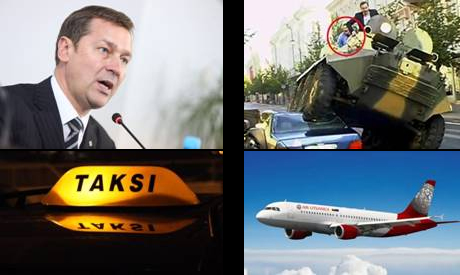










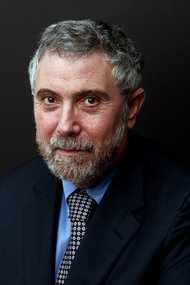

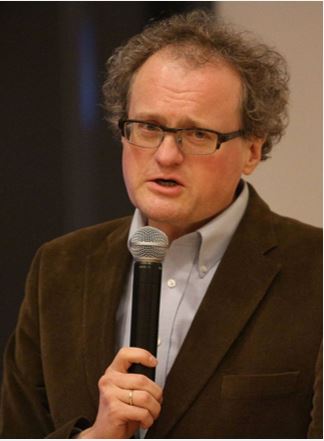
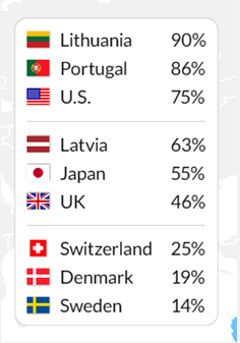
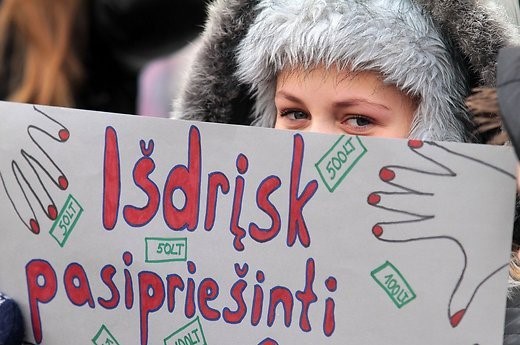



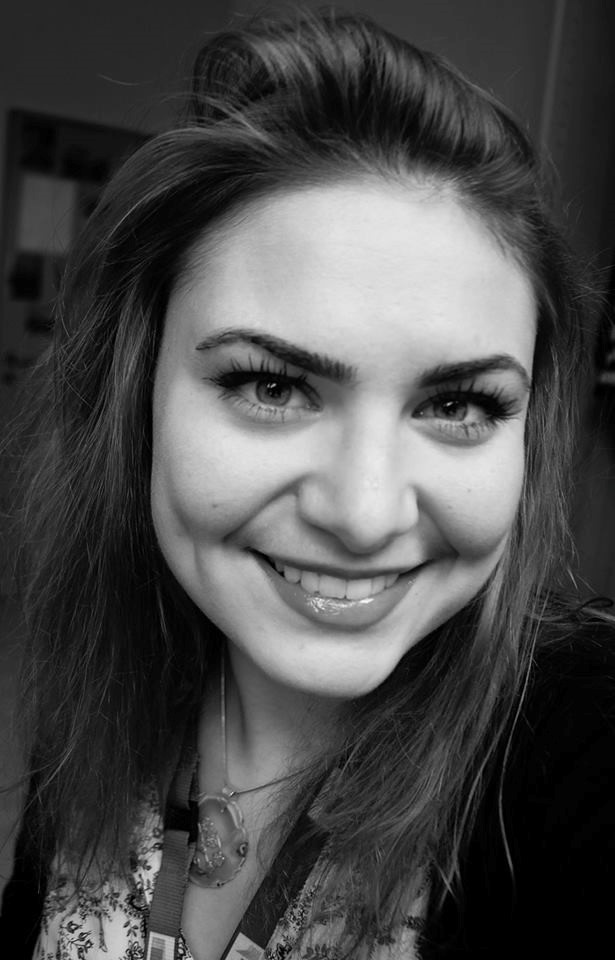
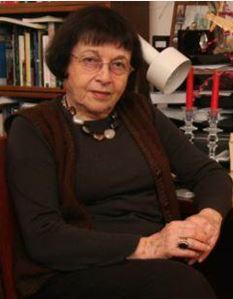
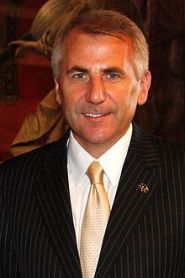
.jpg)
